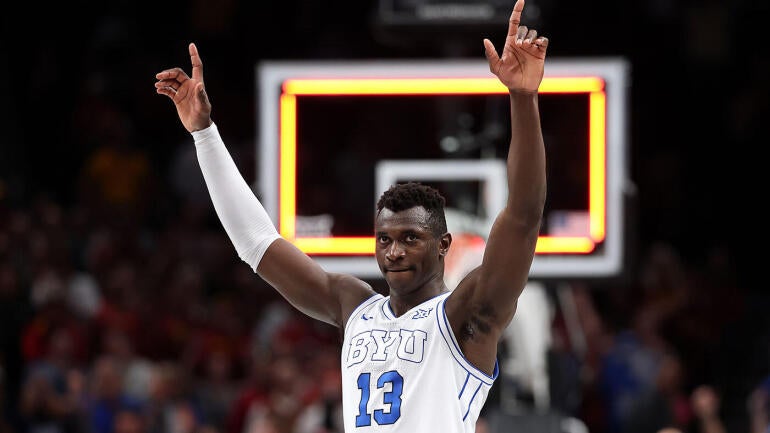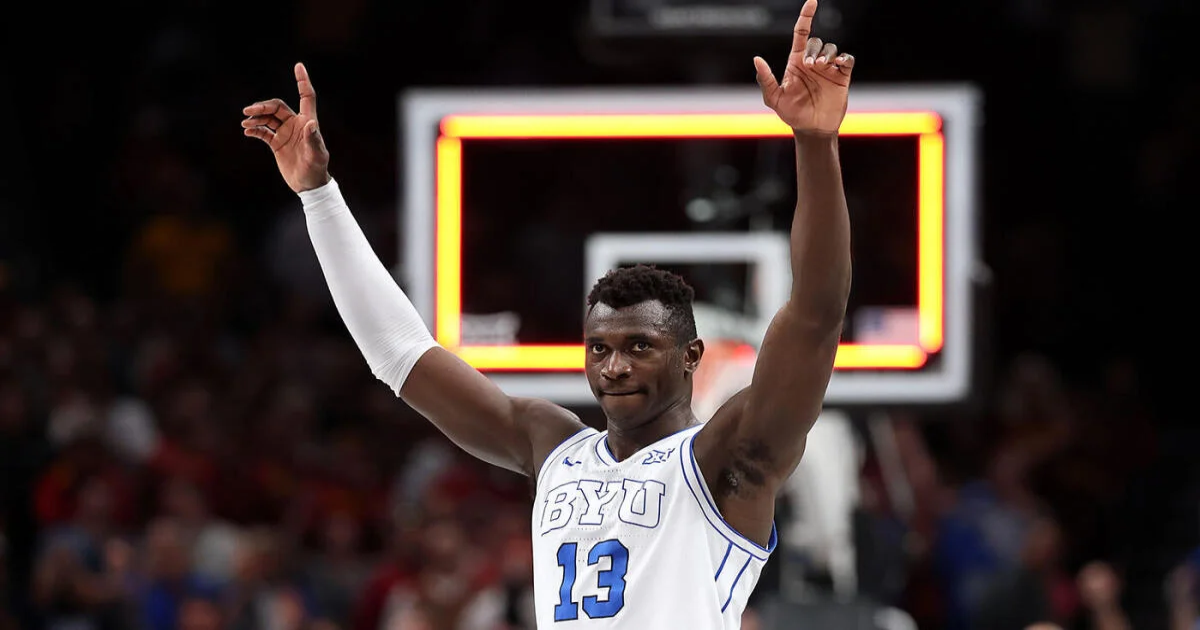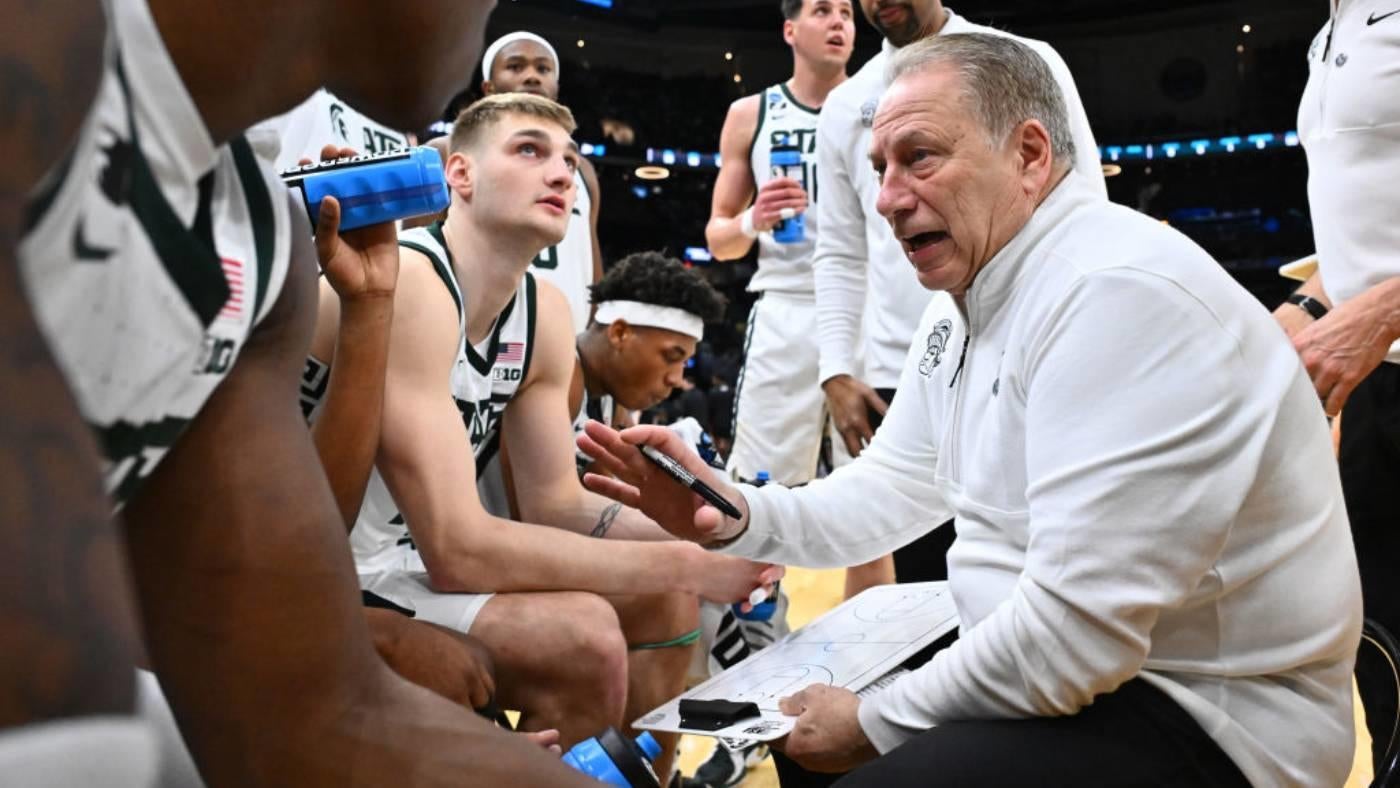
Getty Images
The reports of Cinderella’s demise have been greatly exaggerated, but this year, March has less madness than normal. For the first time since 2007, there’s not a single team seeded 11th or worse is in the Sweet 16, and only four conferences — the record-setting SEC, Big 12, Big Ten and ACC — are left standing.
The only double-digit seed left is (10) Arkansas, and you’ll forgive me if a John Calipari-coached SEC squad loaded with blue-chip talent doesn’t exactly fit the glass slipper.
So on one hand, maybe the lovable underdog storyline hasn’t been fulfilled. But there are storylines aplenty, and the biggest one is just how many good teams there are. That sets up for an intriguing Final Four where even the best teams — especially the excellent No. 1 seeds — are vulnerable.
Just look around at the Sweet 16 underdogs. BYU has the offensive firepower to take down anyone. Maryland’s “Crab Five” starting group can go toe-to-toe with nearly any lineup in the country. Arizona and Arkansas are playing some of their best basketball after uneven stretches earlier in the year. Ole Miss has six wins this season over teams still playing. Kentucky is an underdog against Tennessee despite beating the Volunteers twice this year. Michigan hasn’t lost a tournament game — NCAA, Big Ten or the non-conference Fort Myers Tip-Off — this season. Purdue is the reigning national runner-up and has one of the game’s best point guards.
Lovable, in the traditional March Madness sense? Maybe not. But these underdogs can win. And this late in the season, what more could you ask for? Here’s how the Sweet 16 underdogs can keep things rolling.
All per-possession and specific play-type stats are via Synergy | All times ET | odds via SportsLine consensus.
(2) Alabama vs. (6) BYU
Thursday, 7:09 p.m. on CBS, March Madness Live
Line: Alabama -5.5
Keys for BYU: Let Egor Demin eat in the pick-and-roll, defend the rim
It’d be easy to boil this down to “make shots,” because that’s all that BYU has done this year. The Cougars own the sixth-best effective field goal percentage this season, powered by the sixth-best 2-point shooting percentage (58%) in the country and a healthy 3-point shooting percentage (37%) on a high volume.
Many see BYU’s gaudy offensive numbers and assume it comes from a fast tempo. But BYU is 120th nationally in average possession length on offense, and a big reason for that is the Cougars’ pick-and-roll proficiency. Once they get into halfcourt settings, Egor Demin can pick opponents apart. The 6-foot-9 point guard is a projected lottery pick, and he showed why on the first weekend, averaging 15 points, six rebounds and five assists against VCU and Wisconsin.
Demin is dangerous — and wildly entertaining — in the pick-and-roll, and he made the Cougars go during the first weekend.
The no-look passes, the incredible fakes, the shooting … it’s all ridiculous. It’s also not exactly the norm. Demin went 5 for 13 (38%) from 3 during these two games. He came in shooting 27% from deep.
It also might not matter. Alabama has been one of the worst teams defending the pick-and-roll. How bad? How does 303rd out of 364 D-I teams sound?
On the other end, BYU has to defend the rim well — something it’s done all season. Only two players had more dunks this season than Clifford Omoruyi, and he had 11 over the first weekend of the tournament, feasting on alley-oops. Keba Keita will be key here.
(1) Florida vs. (4) Maryland
Thursday, 7:39 p.m. on TBS, March Madness Live
Line: Florida -6.5
Keys for Maryland: Control the fast break and the boards, make some 3s
A few weeks ago, when I wrote about potential weaknesses for No. 1 seeds, I mentioned good transition defense for Florida. The Gators get it and go as well as anyone, with Walter Clayton Jr. running the show surrounded by a bevy of talented shooters, slashers, scorers and bigs.
UConn nearly pulled it off. The Huskies allowed just eight points in transition and limited the Gators to 2 for 6 shooting with a pair of turnovers on those possessions. That’s well below the Gators’ season average of 19.3 points in transition. The Huskies got back, communicated well and were sound when Clayton and others tried to get downhill.
Enter another good transition defense in Maryland (44th nationally on a per-possession basis). The Terrapins allowed just seven transition points in their first-round win over (13) Grand Canyon and 12 in their nailbiting win over (12) Colorado State. It’s worth mentioning, though, that they allowed 20 transition points in their Big Ten Tournament title game loss to Michigan. They can’t afford that again.
The second-biggest of the many aspects that makes the Gators so good is the offensive glass (fifth-highest offensive rebounding rate in the country). Maryland does a solid job on that end, and Julian Reese and Derik Queen must lead the way in this aspect: Florida can throw a bunch of bodies into the paint, while Maryland leans heavily on its “Crab Five” starting group. Interestingly, Florida is just average on the defensive glass, so perhaps Maryland can steal a few possessions there.
If there’s one clear advantage for the Terrapins, it’s from 3. They shot over 40% from deep in their first two games of the tournament and are 16-2 this season when shooting at least 37% from 3.
(1) Duke vs. (4) Arizona
Thursday, 9:39 p.m. on CBS, March Madness Live
Line: Duke -9.5
Keys for Arizona: Caleb Love, perimeter defense
Well, well, well … they meet again. This will be Caleb Love’s 10th career game against Duke. Here’s how he’s done:
- In five wins: 20.8 points per game, 44% shooting, 36% from 3
- In four losses: 9.8 points per game, 28% shooting, 15% from 3
In the Wildcats’ 69-55 loss to the Blue Devils back in November, Love went 3 for 13 (1 for 9 from 3). A lot of those 3s were good looks, though some were not. We’ll see if he if he can be more efficient. It could be his final college game if not.
Where Arizona absolutely cannot slack off is defending Duke’s jump shooters. The Blue Devils are third in the nation in spot-up shooting, and they get those shots in all sorts of manners: in transition, off drives and kicks and in isolation. Their 1.147 points per spot-up possession is truly absurd. Only last year’s Alabama team was better among major-conference teams in the last four years. Too often in the loss earlier this season, the Wildcats lost shooters in transition and/or via miscommunications. It can’t happen again.
(3) Texas Tech vs. (10) Arkansas
Thursday, 10:09 p.m. on TBS, March Madness Live
Line: Arkansas +5.5
Keys for Arizona: Tighten defensive effort vs. JT Toppin, have one shooter get hot
In the first half of its NCAA Tournament opener, Arkansas allowed 11 points to Kansas’ Hunter Dickinson. Then Dickinson didn’t score in the second half, and the Razorbacks stormed back behind a dominant defensive effort.
Now, Arkansas faces another excellent Big 12 lefty post player: JT Toppin, the conference player of the year. The Razorbacks threw plenty of bodies — Jonas Aidoo, Zvonimir Ivišić and Trevon Brazile — at Dickinson, and expect them to potentially add Adou Thiero to that mix as well now that he’s back from injury. Arkansas is one of the best rim-protecting teams in the nation, and it’ll need that against Toppin.
The Razorbacks need a big game from at least one of those four players — Aidoo’s 22 points against Kansas showed he clearly outplayed Dickinson on both ends — because the perimeter shooting is dismal. They went 2 for 19 from 3 against St. John’s i in the second round after going 6 for 24 from 3 against Kansas in the first round. Overall, they are 246th in 3-point shooting percentage.
The Razorbacks don’t need to match the Red Raiders from deep, but they will likely need at least one guy to get going, or else it’ll simply be too much of a math problem. In some of Arkansas’ best regular-season wins, they got some surprise shooting. In a win over Mississippi State, Brazile, DJ Wagner and Johnell Davis each hit three 3s, and in a win over Kentucky that got Arkansas’ turnaround started, Ivišić made four.
(2) Michigan State vs. (6) Ole Miss
Friday, 7:09 p.m. on CBS, March Madness Live
Line: Michigan State -3.5
Keys for Ole Miss: Spread the floor, keep the turnovers down
Ole Miss shot a scintillating 19 for 39 (49%) from 3 over the first weekend of the tournament. That’s probably not sustainable, but the Rebels need to lean into their 3-point prowess against Michigan State. All six of the Rebels’ most-used players are threats from deep, including bigs Malik Dia and Jaemyn Brakefield (both 35%), a luxury few other teams have.
Michigan State led the country in 3-point defense, but Ole Miss presents a completely different test. The Rebels run all sorts of offensive actions and have a pair of capable pick-and-roll directors in Sean Pedulla and Jaylen Murray. While the Spartans’ defense has been magnificent all year, it’s been just OK in pick-and-roll action, and if one of Dia or Brakefield can pop out beyond the arc and continue to make 3s, that puts the Spartans’ bigs in a tough spot.
Again, the 3-point shooting from the first weekend was an anomaly. So, too, were the 22 turnovers. Simply put, this is one of the best turnover teams in the nation, powered by a deep stable of capable ball handlers and skilled bigs. Michigan State’s defense doesn’t generate a ton of turnovers, and they’re also just average in terms of offensive turnover rate, whereas the Rebels force a ton of miscues. If Chris Beard’s team can get some extra possessions this way, it’ll be a big help.
(2) Tennessee vs. (3) Kentucky
Friday, 7:39 p.m. on TBS, March Madness Live
Line: Tennessee -4.5
Keys for Kentucky: Drive and kick, lock in on Chaz Lanier
The clearest advantage for Kentucky is shooting. The Wildcats outscored the Volunteers 44-15 in spot-up shots during their regular-season sweep because they managed to touch the paint first before kicking out to shooters.
The Wildcats have several ways to get the ball inside, with guards Lamont Butler and Otega Oweh as capable drivers. But they also have the rare big man who can operate as an offensive hub. Amari Williams is a willing and skilled passer who dished out six assists in the two aforementioned names.
Once Kentucky gets the ball inside, it has a ton of guys who can shoot the lights out. Koby Brea (44%) and Ansley Almonor (43%) lead the way there, but Oweh (36%) and Andrew Carr (33%) can also get going, as can several bit players.
Tennessee doesn’t have that advantage, and it showed in its two matchups against Kentucky. Chaz Lanier shot just 3 for 17 from 3 across those two games, and Zakai Zeigler was 1 for 13. Igor Milicic actually did a great job stepping up, but the vast difference in spot-up points speaks for itself.
(1) Auburn vs. (5) Michigan
Friday, 9:39 p.m. on CBS, March Madness Live
Line: Auburn -9.5
Keys for Michigan: Stay poised, use your size
In March, a turnover or two can feel like 20, a 6-0 run conceded like 60-0. It can also feel that way on the road, especially at Auburn, where “The Jungle” often swallows opponents whole.
Michigan, plainly, can’t let it happen. The Wolverines were one of the loosest with the ball this year (324th in turnover rate), and they don’t force very many to help balance that out. Michigan keeping its turnovers down against Texas A&M was a huge reason for its victory.
So, too, were its size and rebounding prowess. Michigan secured 16 offensive rebounds against the Aggies and “limited” Texas A&M to 15. That may sound like a lot, but Michigan won the offensive rebound rate 40% (well above its average) to 32% (well below the Aggies’ average). Looking ahead, both Michigan and Auburn hit the offensive glass well, so Vladislav Goldin and Danny Wolf both need to do their part down low. Michigan’s guards and wings must chip in, too.
Oh yeah, and it will help if Roddy Gayle continues his shooting rebirth. He was 20% from deep entering the tournament, but he’s hit 5 of 9 so far in March Madness.
(1) Houston vs. (4) Purdue
Friday, 10:09 p.m. on TBS, March Madness Live
Line: Houston -8.5
Keys for Purdue: Make non-guards beat you, make your 3s
In the past, the key to beating Houston was hope the Cougars continue to struggle shooting the ball and hang in well enough on the boards. Kelvin Sampson’s bunch was often at its best after the first shot was in the air, generating a ton of offensive rebounds.
That’s no longer the case. Houston is the best 3-point shooting team in the country. All three starting guards — LJ Cryer, Milos Uzan and Emanuel Sharp — shoot it at over 42% from 3. Then you add in the usual offensive rebounding vigor (11th in OREB rate) and defensive toughness (first in efficiency) of a Sampson team, and you get an absolute wagon. The Cougars have lost just once since December 1.
But we’re not here to talk about why Houston can win. Purdue must be on its Ps and Qs defensively and try its best to make the non-guards beat you. Houston is 272nd in 2-point shooting percentage this year. The Boilermakers should effort to extend its closeouts and run Houston’s guards off the 3-point line. In Houston’s worst offensive game of the year — a 60-47 win over Oklahoma State in December — Cryer made four 3s and Uzan made two, but no one else made a shot beyond the arc. Sharp only took two 3s and four shots total.
There’s also a bit of fighting fire with fire here. Purdue is ninth nationally in 3-point percentage, and with Braden Smith pulling the strings, they can generate plenty of good looks. Fletcher Loyer (45% from 3) and Smith (38%) must lead the way, but there are other capable shooters who must step up, too.
Who will win every college basketball game, and which favorites should be on upset alert? Visit SportsLine now to get picks and predictions for every college basketball game, all from a model that simulates every game 10,000 times.


